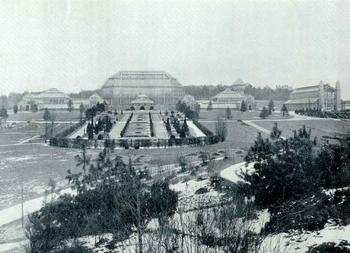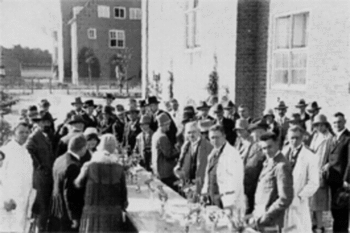History of Plant Sciences in Dahlem
Botanic Garden Berlin-Dahlem, view of the greenhouses, 1909
Image Credit: Ministerium der geistlichen, Unterrichts- und Medizinal-Angelegenheiten (Hrsg.): Der Königliche Botanische Garten und das Königlich Botanische Museum zu Dahlem. Horn&Raasch, Berlin 1909
International Congress for Genetics in Berlin 1927. Visit at the Institute of Heredity Research of the Royal Prussian Agricultural University.
Berlin-Dahlem is a historical site for plant sciences. Before the foundation of the Freie Universität Berlin in 1948 this district homed the Botanic Garden and its associated botanical research facilities, the Royal Prussian Agricultural University and several Kaiser Wilhelm Institutes, the predecessors of the Max-Planck-Institutes. In the first decades of the 20th century, major contributions to plant sciences were made, among others, by Carl Correns (rediscovery of Mendel´s law), Richard Willstätter and Arthur Stoll (structure of chlorophyll and anthocyanins; Nobel prize for Willstätter in 1915), Otto Warburg (photosynthesis and primary metabolism; Nobel prize in 1931), Adolf Engler (plant systematics), Erwin Baur (heredity of chloroplasts) and Gottlieb Haberlandt (physiological plant anatomy).
The Botanic Garden and Botanical Museum (BGBM) of the Freie Universität Berlin look back on a tradition of more than 300 years. The Botanic Garden was founded in 1679 following a directive of the Great Elector of Prussia and moved in 1907 to Berlin-Dahlem under its director A. Engler. Today, the Botanic Garden is a leading institution for recording and conservation of botanical biodiversity. It is the third largest of its kind, with respect to area (43 ha), number of plant species cultivated (ca. 22.000) and size of herbarium (about 3.5 million specimen). The latter include the world-famous collections of Carl Ludwig Willdenow and Alexander von Humboldt. The Botanic Garden possesses also an excellent library, extensive databases, and the only Botanical Museum of Central Europe is located on its grounds. The beginning of the Botanical Museum dates back to 1815. It was established on the collections of the “Royal Herbarium” and later named “Royal Botanical Museum” (1879). Despite major losses during the Second World War, the Botanical Museum shows rich exhibits documenting diverse aspects of plant life, including plant geography and paleobotany.
In 1922, the Institute of Heredity Research of the Royal Prussian Agricultural University was founded by E. Baur, a pioneer of plant breeding and one of the leading geneticists of his time. He started the first genetic experiments in 1904 in the former Botanical Garden, shortly after the rediscovery of Mendel´s laws and obtained the first Chair of Genetics at a German university. Baur built in Dahlem the first genetics institute in Germany, aiming to facilitate the transfer of the results of this then novel branch of biological science to agriculture. Since 1972 the institute is a department (Applied Genetics) of the Institute of Biology of the Freie Universität Berlin.
The history of plant physiology in Berlin-Dahlem started with the arrival of Gottlieb Haberlandt in 1910. He founded the Institute of Plant Physiology close to the Botanical Garden (Königin-Luise-Str. 1-3, today Department of Zoology). He was one of the leading botanists and still well-known for his groundbreaking work linking plant anatomy with functional physiological aspects. He has also been the first to establish plant cell and tissue cultures in vitro. In 1970, the department of Plant Physiology moved to its new building which houses nowadays also plant biochemistry and microbiology.
Plant ecology started in the 1950s at the location Rothenburgstraße; in fact the institute located there was the first “Institute of Ecology” at a German University (founded 1973), belonging to Technische Universität Berlin. The plant ecology at TU Berlin is still located at this site, since 1999 led by I. Kowarik. At Freie Universität, the plant ecology department is a new addition to the Institute of Biology. It started in 2007 with the appointment of M. Rillig to this position, and is located at Altensteinstraße in Berlin-Dahlem. The main focus of this group is the interaction of plants with soil biota.
The Institute of Pharmacy was the first institute of the Friedrich-Wilhelms University built in Berlin-Dahlem and opened in 1902. Since 1896 it was planned to connect the Botanical Garden with the new institute. The first director was Hermann Thoms, he was responsible for the chemical and toxicological training of the students. The lectures in botany, bacteriology and pharmacognosy were given by professors of the Institute of Botany, H. Engler and E. Gilg. One of the main research topics in the years after founding the institute were investigations of plants and herbal drugs from German overseas possessions in the so called “Kolonialchemische Abteilung”. Together with the director of the Botanical Garden, H. Engler, especially plants containing rubber, essential oils and camphor were investigated and collected in a special drug collection. This collection was destroyed in World War II, only relicts are preserved.
The subject pharmacognosy, now called pharmaceutical biology has a long tradition in the history of science in Berlin and is connected with the therapeutic use of g-strophantin by H. Thoms or the isolation of cardiac glycosides by K. Mannich.
In addition to these institutions of the Freie Universität Berlin, Berlin-Dahlem is home of several other institutions performing plant-related research. In particular, these include the Faculty of Agriculture and Horticulture of the Humboldt University and the Julius Kühn Institute.
For more information see: Geschichte der Botanik in Berlin. Eds. Claus Schnarrenberger and Hildemar Scholz, Colloquium Verlag Berlin, 1990.




